If you want to conquer hills, you need an e-bike that's built for the job. The secret sauce is a powerful mid-drive motor, plenty of torque, a beefy battery, and a good range of gears. As a rule of thumb, look for at least 60 Newton-meters (Nm) of torque and a battery with 500 Watt-hours (Wh) or more. That combo gives you the oomph to get up steep climbs and the juice to keep going.
Why Hills Are an E-Bike's Ultimate Test
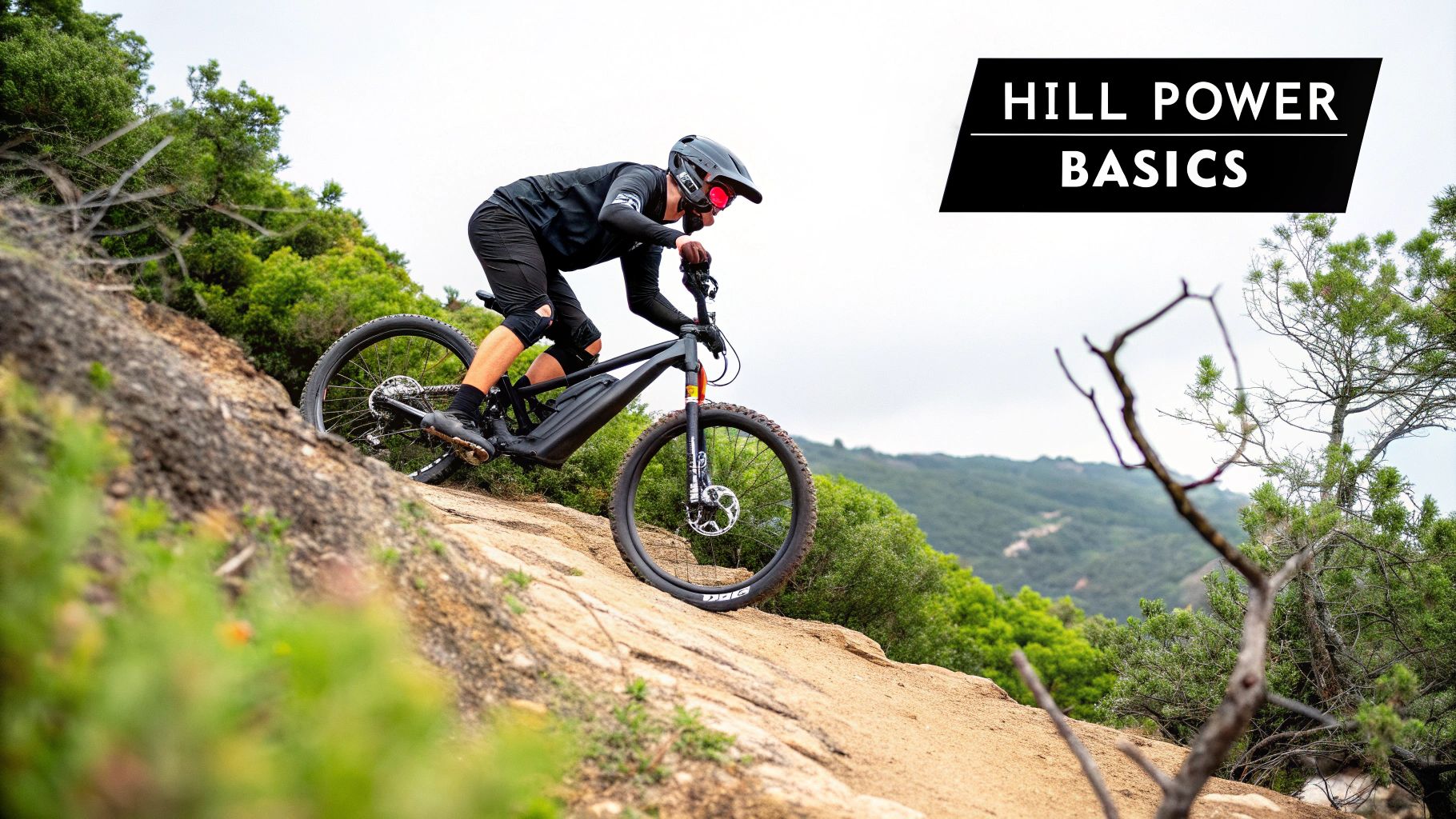
Remember that leg-burning, lung-busting feeling of trying to grind up a steep hill on a regular bike? We’ve all been there. Hills are the great equalizer in cycling, and for an e-bike, they're the ultimate final exam. It's where the machine's true character is revealed.
An e-bike can feel like a dream on a flat, smooth path, but a tough incline will expose any weakness in a heartbeat. This is where a well-engineered bike truly stands out. It's not about just slapping a big motor on a frame; it’s about how all the components work together to make that climb feel almost easy.
The Physics of the Climb
Let's get down to it: climbing a hill is a fight against gravity. Simple as that. Your e-bike’s motor has to produce enough force to push you, the bike, and your gear up that slope, all while battling the normal friction from the road.
Think of it like trying to drive a 4x4 up a muddy, slick track. You can have a massive engine, but without the right torque and gearing, your wheels will just spin and you'll be stuck. An e-bike is no different. It needs a smart system, not just brute force.
The real challenge is getting these three things to work in perfect harmony:
- Motor Power and Torque: This is your engine, providing the raw pulling force.
- Battery Capacity and Output: This is your fuel tank, determining how long that power lasts.
- Gearing and Drivetrain: This is your transmission, making sure the power gets to the wheel efficiently.
A classic rookie mistake is to get fixated on a motor's wattage. Sure, it matters, but torque is the real MVP for climbing hills. Torque is that rotational force that gets you moving from a dead stop on an incline. A high-torque motor can make a steep 15% gradient feel like a gentle slope.
Setting the Stage for Success
Getting your head around these core ideas is the first step to finding your perfect hill-climbing partner. The rolling hills of the Appalachians, the steep streets of San Francisco, or the rugged trails of the Australian bush demand an e-bike that’s more than just a fair-weather commuter. You need a reliable workhorse you can trust, no matter what the terrain throws at you.
This guide is here to cut through the marketing fluff. We'll break down each of these critical parts and explain what the numbers actually mean for your ride. By the time we're done, you'll know exactly what to look for and be able to spot the features that make a truly great hill-climbing e-bike. Your next ride should be a smooth ascent, not a sweaty struggle.
Understanding E-Bike Motors and Torque
Let's get right to the heart of the matter: the motor. When you're staring up at a monster hill, the motor is what makes the difference between conquering it and walking it. It's the engine that turns a grueling climb into an almost effortless spin. But not all e-bike motors are built the same, and knowing what to look for is your ticket to a great ride.
Lots of people get fixated on wattage (W), thinking that a bigger number automatically means a better bike for hills. Wattage is more like horsepower in a car—it's great for maintaining speed on the flats. But for climbing? It's not the whole story. For that, we need to talk about torque.
Torque: The Secret Sauce for Climbing
Torque, measured in Newton-meters (Nm), is the pure, raw twisting force the motor puts out. Think about trying to loosen a stubborn bolt with a wrench. The force you apply to turn it? That’s torque. On an e-bike, torque is what gets you going from a dead stop on a steep incline and keeps pulling you up without making you sweat.
Torque is the grunt. It's the sheer pulling power that can make a steep 15% grade feel like a gentle slope. While wattage helps you go fast, torque is what helps you go up.
An e-bike’s motor power and torque are the biggest factors in its hill-climbing ability. Motors usually range from 250W to 750W, but as we've said, torque is arguably more important for serious climbs. Most experts agree you should look for a motor with at least 60Nm of torque to comfortably tackle hills.
Of course, a 750W motor will generally feel more powerful and require less pedaling effort on steep terrain than a 250W model. This is especially true in markets like the US and Australia where higher-powered motors are more common and legally permitted. A 750W system can make a significant difference on challenging American or Australian landscapes.
The image below gives you a quick visual on how different e-bike models stack up when it comes to the specs that matter for tough terrain.
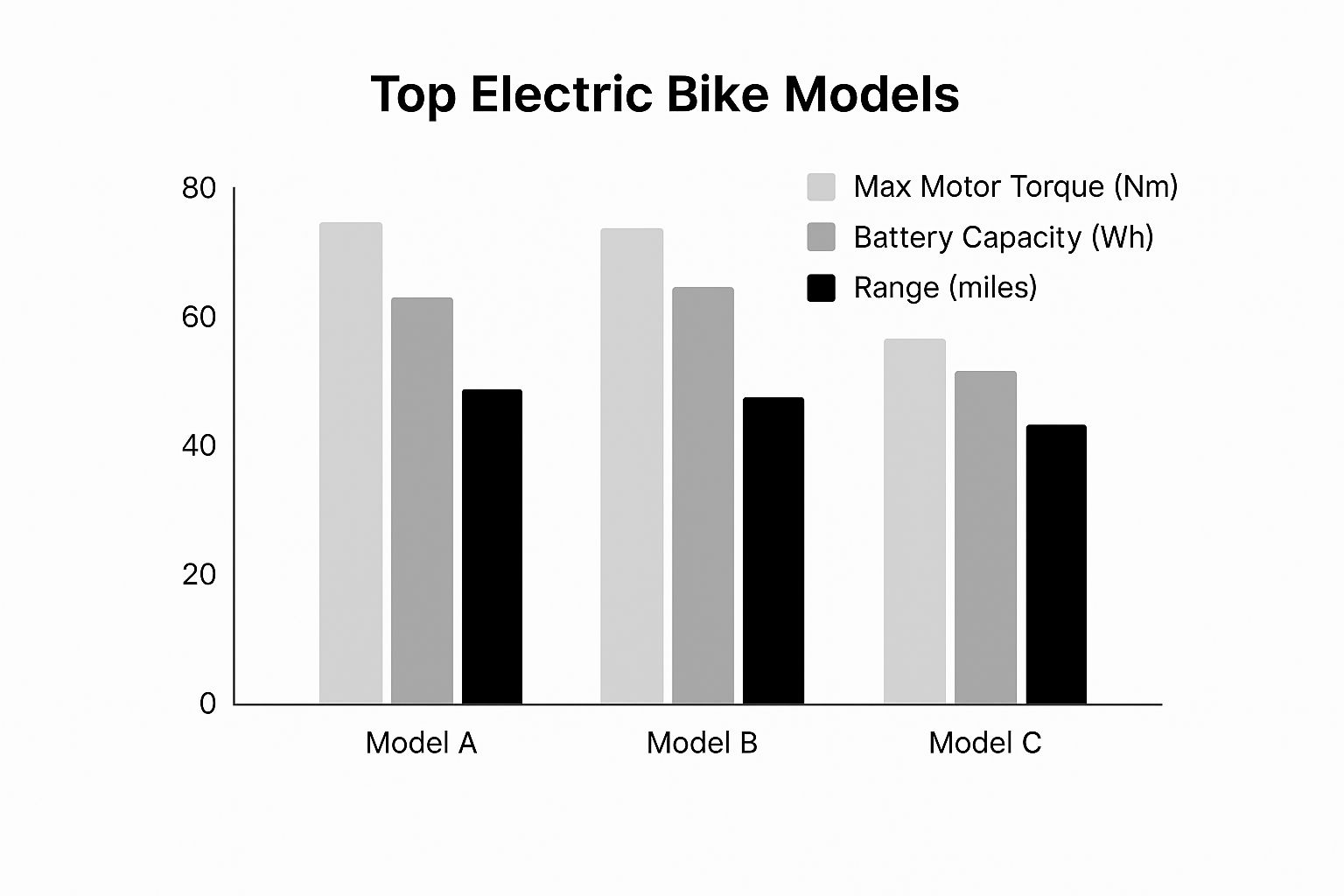
As you can see, bikes with higher torque numbers almost always deliver better climbing performance, even when their battery size or range is similar.
To break it down even further, here's a simple comparison of what wattage and torque bring to the table for hill riding.
Motor Power vs Torque for Hill Riding
This table gives a clearer picture of how these two key metrics function and what you should look for based on the kind of hills you plan to ride.
| Metric | What It Means | Good for Gentle Hills (Urban Commutes) | Ideal for Steep Hills (US/AU Terrain) |
|---|---|---|---|
| Power (Watts) | The motor's ability to sustain output; think of it as the engine's horsepower. It helps maintain speed. | 250W - 500W is often sufficient for moderate inclines. | 750W+ provides the extra punch to maintain speed on steep climbs. |
| Torque (Nm) | The raw twisting force for acceleration and climbing; think of it as the engine's "grunt." It gets you up the hill. | 40Nm - 50Nm will handle rolling hills and moderate inclines without much trouble. | 60Nm - 85Nm+ is what you want for tackling steep gradients and starting on an incline. |
In short, while wattage is important, torque is the real hero when the road points skyward. A bike with high torque will feel powerful and responsive right when you need it most.
Hub-Drive vs Mid-Drive: The Great Motor Debate
Okay, so where the motor is placed on the bike matters. A lot. You’ve got two main camps: hub-drive and mid-drive. And for hills, there's a clear winner.
-
Hub-Drive Motors: These are built into the hub of the front or, more commonly, the rear wheel. They're simple, usually quiet, and more budget-friendly. They work by directly spinning the wheel, giving you a "push" or "pull" feeling. The big drawback? They operate independently of your bike's gears. On a long, steep climb, they can't downshift to gain leverage, which can cause them to struggle and even overheat.
-
Mid-Drive Motors: As the name suggests, these are mounted in the middle of the frame, right where your pedals are. This is a brilliant piece of engineering because the motor sends its power through your bike's own drivetrain—the chain and gears. It’s a total game-changer for hills. By shifting into a lower gear, you're not just making it easier for yourself to pedal; you're also allowing the motor to spin in its sweet spot, multiplying its torque to tackle insane inclines without breaking a sweat.
Because of this incredible efficiency, a 250W mid-drive motor can easily outperform a 500W hub-drive motor on a steep hill. This makes mid-drives the hands-down choice for anyone who is serious about riding in hilly areas.
While we're focused on e-bikes here, the same core principles apply to other electric rides. If you're curious, you can compare electric scooter performance in our other guide. The bottom line is, for any electric vehicle, understanding how the motor works is the key to mastering your terrain.
Your E-Bike's Power Source: Battery Capacity and Voltage
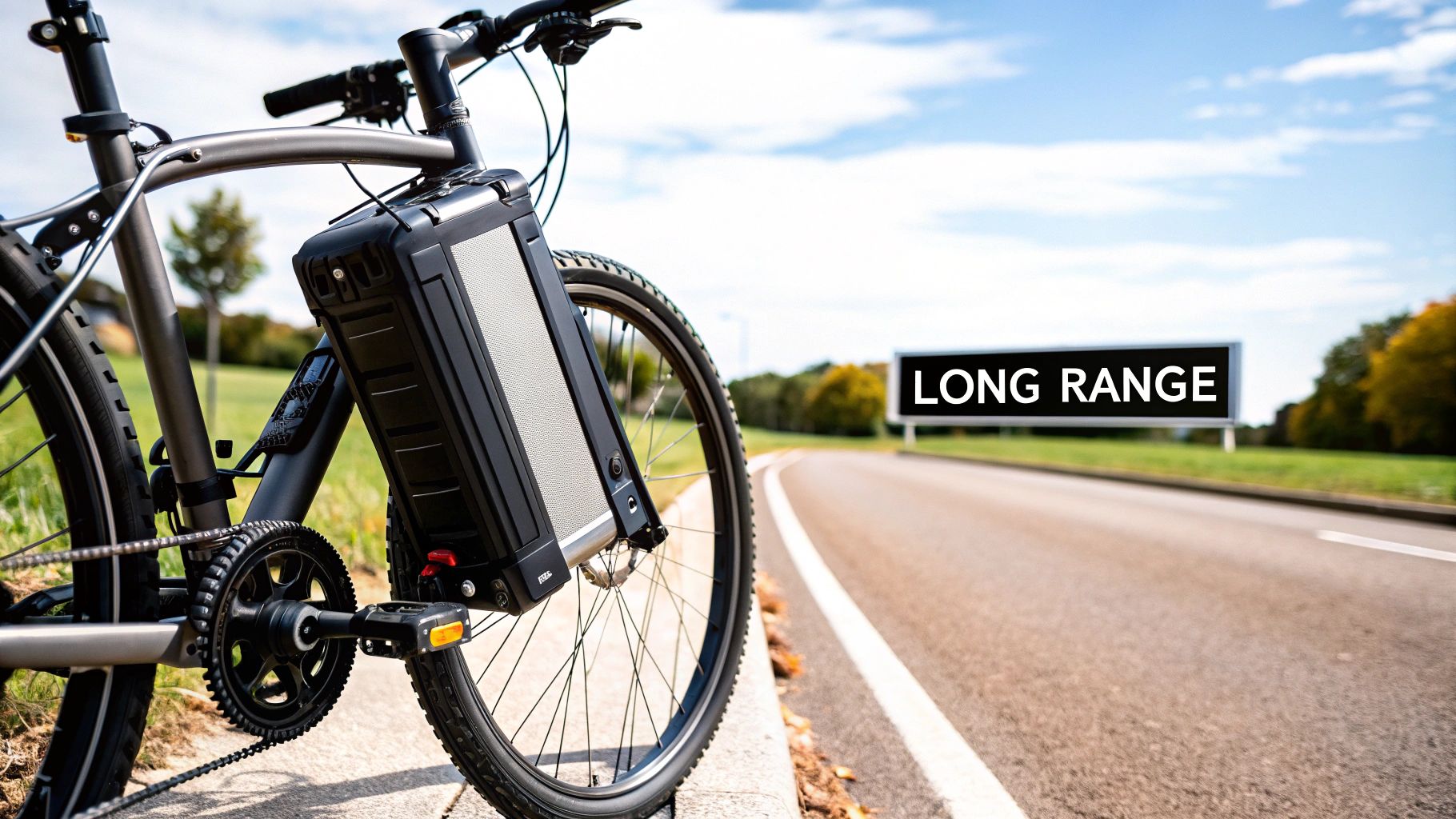
Having a motor with a ton of grunt is a great start, but it's only half the story when it comes to conquering hills. Think of it like a high-performance car engine—it's pretty useless without a decent fuel tank. For an e-bike, that fuel tank is the battery.
Climbing hills is incredibly demanding, and it will drain your battery way faster than cruising on a flat path. This is why you need to pay just as much attention to the battery specs as you do to the motor. Two key numbers will tell you almost everything you need to know: capacity and voltage.
Capacity: How Big Is Your Fuel Tank?
Battery capacity is measured in Watt-hours (Wh). The easiest way to wrap your head around this is to think of it as the size of your e-bike’s fuel tank. A bigger Wh number means more energy stored, which translates to more miles before you need to plug it in.
When you're grinding up a steep hill, your motor is working overtime and gulping down power. A small-capacity battery can get emptied at an alarming rate under that kind of strain. A battery that gives you a comfortable 50 miles on a flat bike path might be toast in less than 25 miles in a seriously hilly area.
This is why a larger battery is a non-negotiable feature if you plan on tackling inclines.
We consider a battery with 500Wh a solid starting point for anyone riding regular hills. But if you live somewhere with truly challenging terrain, stepping up to the 600Wh to 750Wh range will give you the peace of mind to attack those climbs without constantly worrying about your range.
Voltage: The 'Oomph' Behind the Power
If capacity is the size of the fuel tank, then voltage (V) is the pressure pushing that fuel to the motor. It’s the electrical force that gets the power where it needs to go.
Many standard e-bikes run on a 36V system, which is perfectly fine for general use. But the more powerful models built for tough terrain often use 48V or even 52V systems, which are especially common on US and Australian models.
A higher voltage system is just more efficient at delivering power, especially when the motor is under a heavy load—like when you're halfway up a monster climb. This efficiency means the whole system runs cooler and can provide sustained power without feeling sluggish. On a steep hill, a 48V bike will feel more responsive and punchy than a 36V bike, even if their motors have the same wattage rating.
Putting It All Together
An e-bike's real-world hill-climbing ability comes down to how the motor's torque, wattage, and the battery's capacity all work together. A typical hub-motor bike might offer 40 to 60 Newton-meters (Nm) of torque, which is fine for moderate hills around a 5-7% grade.
But once you hit steeper hills of 10% or more, battery consumption can shoot up by 20-30%. Your range of 25-50 miles on the flat could suddenly drop to just 20-40 miles.
Choosing the right battery is absolutely crucial. You need a power source that won't leave you stranded when the going gets tough. This trade-off between power and weight isn't unique to e-bikes; our guide on the best lightweight electric scooters dives into similar challenges for city commuters.
At the end of the day, don't let a fantastic motor be held back by a wimpy battery. A robust battery with plenty of capacity and voltage is the powerhouse that will keep you pedaling upward, turning tough climbs into the best part of your ride.
Why Your Gears and Pedal Assist Are a Team Effort
So you've got a beefy motor and a big battery. Great! But if you think you can just slam the pedal assist to max and let the bike do all the work on a steep climb, you're in for a surprise. That's one of the quickest ways to kill your battery and find yourself grinding to a halt.
Think about driving a car up a steep hill. You wouldn't leave it in fifth gear, right? The engine would lug, groan, and burn a ton of fuel without getting you very far. Your e-bike's motor is no different—it has a sweet spot where it runs most efficiently.
That’s where your good old-fashioned gears come in. Dropping into a lower gear lets you keep pedaling at a nice, steady rhythm. This rhythm is called your cadence. Keeping your legs spinning smoothly helps the motor stay in its happy place, giving you power without chugging your battery. It's a true partnership between you and your bike.
Finding That Perfect Spin
The goal on any climb is to maintain a steady cadence—a smooth, consistent spin—instead of mashing down hard on the pedals. When you click into the right gear, your pedaling feels fluid, and the motor’s power kicks in seamlessly to help you along. That synergy is what makes climbing on a great e-bike feel so amazing.
The motor isn't taking over; it's just amplifying your own effort. This smart teamwork doesn't just make the climb feel easier—it has a massive impact on your range. Forcing the motor to grind away in the wrong gear is a guaranteed way to drain your battery fast.
By using your gears wisely, you can often climb the same hill on a lower pedal assist setting. Not only do you get a better workout, but you also save a ton of battery, leaving you with plenty of juice for the rest of your adventure.
Why More Gears Are Your Friend
When you're tackling rolling hills or serious mountain climbs, a wider gear range is your best friend. Look for e-bikes that have a good number of gears, usually found on the cassette on the back wheel. This gives you more options to fine-tune your effort and find that perfect cadence for any gradient.
The dream team for hill-climbing is a combination of mechanical gears and multiple pedal assist levels. For example, a 7-speed gear system paired with a 5-level PAS is a fantastic setup. The gears multiply the force from your legs, helping you maintain that ideal 70–90 RPM cadence. At the same time, the PAS gives you that electric push without overworking the motor. This dynamic duo means smoother climbs, better control, and a much, much happier battery. You can dive deeper into how these systems work together in this helpful article.
How to Master the Climb
Think of your gears and your PAS levels as two different toolkits for tackling hills. Learning how to blend them is the secret to conquering any incline.
Here’s a simple strategy to get started:
- Get Ready Early: See a hill coming? Shift into an easier gear before you start the climb, not halfway up it. You can also bump up your PAS by a level or two at the same time.
- Keep Spinning: As the hill gets steeper, keep shifting down into easier gears to maintain that smooth pedaling rhythm. You want to avoid that slow, heavy, grinding feeling at all costs.
- Add Power When Needed: If the climb gets seriously tough, don't be afraid to increase the PAS for that extra boost. Once you’re over the top, dial it back down to save your battery.
Using this approach turns a tough climb from a chore into a fun challenge. You’re in control, working with your bike to float up hills you used to dread. This is essential know-how for anyone on the hunt for the best electric bikes for hills.
Essential Features for Hilly Terrain
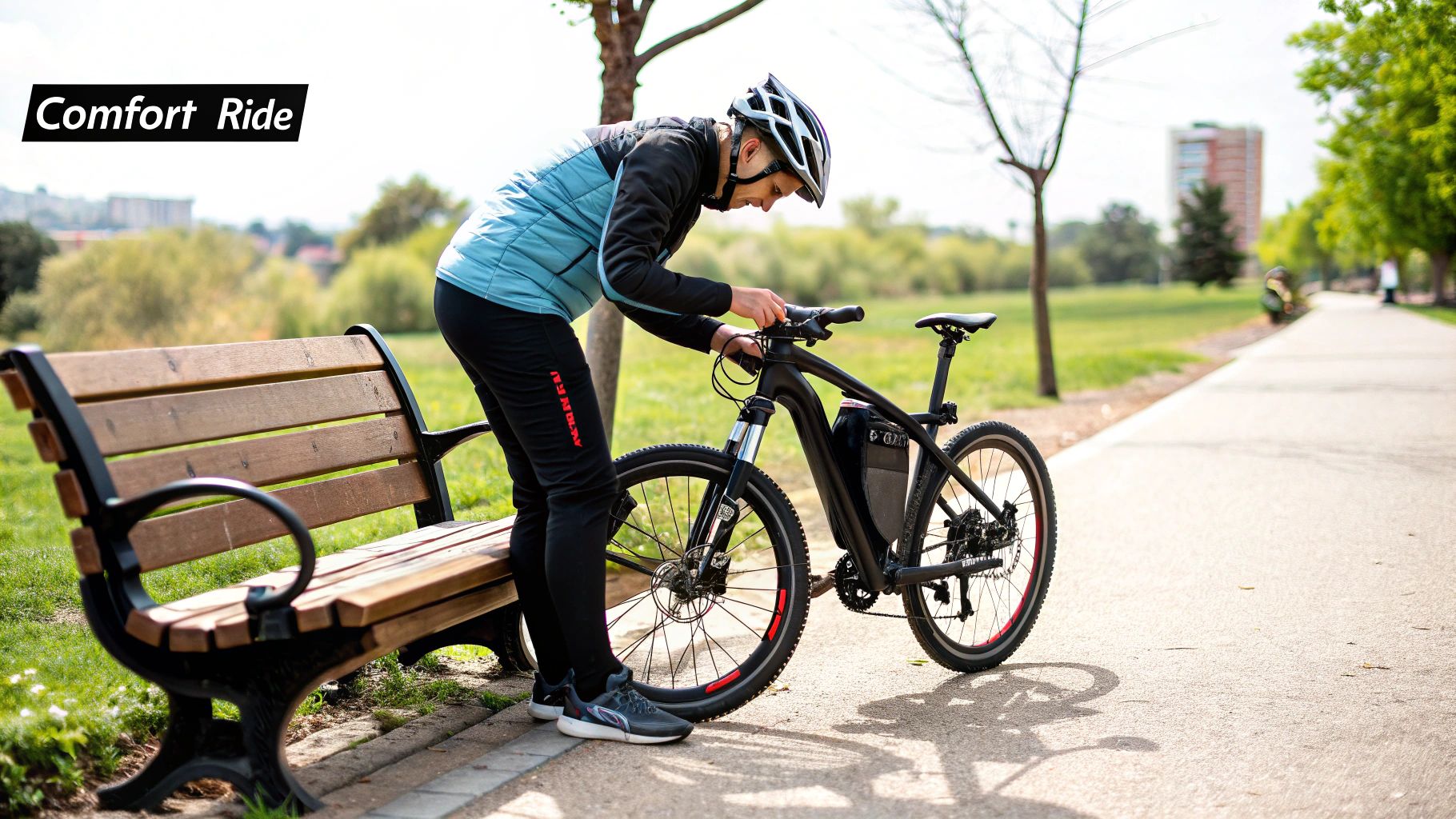
A beefy motor and a long-range battery are your star players, for sure, but they can't win the game by themselves. When you're tackling serious hills, the rest of the bike’s components are just as critical. After all, what goes up must come down, and you need to be in complete control every single second.
So, let's look at the supporting cast—the frame, brakes, and tires—that elevate a good e-bike into one of the best electric bikes for hills. These are the parts that provide stability on the way up and, more importantly, safety on the way down.
Frame Geometry for Stability and Control
You might not think about it much, but the very shape of your e-bike’s frame is a huge deal, especially when you start climbing. A smart frame design distributes the weight of the motor, battery, and you, the rider, evenly across the bike. This is the secret to staying balanced, particularly when that front wheel gets a little light on a super steep pitch.
Bike designers nail this by placing the heavy parts—the motor and battery—as low and central as possible. This creates a low center of gravity that makes the bike feel glued to the ground and totally predictable. Good, stable geometry gives you the confidence to just focus on pedaling up that beast of a hill without any wobbles.
Why Powerful Brakes Are Non-Negotiable
Okay, you just crushed that climb. The reward? A long, fast descent. This is the moment your brakes become the most important part of your entire bike. When you're trying to control a heavier e-bike hurtling downhill, hydraulic disc brakes are an absolute must-have.
Here's why they are the undisputed champs for hilly rides:
- Serious Stopping Power: Hydraulic brakes use fluid to multiply the force from your hand, giving you way more stopping power with less effort than old-school mechanical brakes.
- Better Feel and Control: They let you "modulate" your braking. You can gently feather the brakes to shave off a little speed in a corner or grab a handful for a sudden stop with total confidence.
- Works in Any Weather: Rain? Mud? No problem. Hydraulic brakes perform consistently and reliably, which is exactly what you need when conditions get messy.
Seriously, don't skimp on brakes. The extra weight and speed of an e-bike put a massive demand on the braking system. Mechanical disc brakes or (even worse) rim brakes just can't provide the safety and control you need for steep descents.
Tires: The Final Piece of the Puzzle
Your tires are the only thing connecting you and your bike to the ground. They have the tough job of taking all that power from the motor and your legs and turning it into forward motion. The right set of tires gives you the grip to claw your way up steep climbs without spinning out, whether the surface is loose, gravelly, or a bit wet.
Look for tires that are a little wider than what you'd find on a standard city bike. A wider tire means a bigger contact patch with the ground, which translates to better traction. A decent tread pattern is also key. You don't necessarily need huge, knobby mountain bike tires, but a bit of texture will help you bite into the surface and keep you from losing momentum.
So, How Do You Pick the Right E-Bike for Hills?
Alright, let's put all this theory into action and get you ready to shop with confidence. Picking the best electric bike for hills isn't about finding a single "perfect" bike; it's about matching the right machine to your specific rides and the inclines you plan to conquer.
Think of it less like a test and more like assembling your ultimate hill-climbing sidekick. You just need to know which parts matter most.
Your Hill-Conquering Checklist
As you start comparing different models, keep these numbers and features in your back pocket. They're what separate the true mountain goats from the ones that will leave you huffing and puffing.
- Motor Type: Go for a mid-drive motor. Seriously, this is the biggest game-changer. It leverages your bike's gears, giving you the torque you need to crawl up steep grades efficiently without burning out the motor.
- Torque: Look for at least 60 Newton-meters (Nm) of torque. If you live somewhere with seriously steep climbs, pushing for 80Nm or more will make you feel like a superhero.
- Battery Capacity: A 500-watt-hour (Wh) battery should be your absolute minimum. For long, hilly adventures, a bigger tank of 600Wh to 750Wh is the way to go for total peace of mind.
- Brakes: This one is non-negotiable: you need hydraulic disc brakes. They provide the reliable, powerful stopping power required to control a heavier e-bike on steep descents. Safety first!
Test riding an e-bike is just like test-driving a car. Don't just noodle around a flat parking lot. Find a real hill! You need to feel how the motor engages under pressure and, just as importantly, how the brakes handle the descent.
The All-Important Test Ride
When you're finally on the bike, pay close attention to how it feels. As you start up a hill, drop into an easier gear and notice how the pedal assist responds. It should feel like a smooth, powerful push from behind, not a sudden, jerky lurch. The bike should feel solid and stable, keeping you in complete control.
To make things even easier, here's a quick checklist you can use when you're looking at different bikes online or in a store.
Hill-Climbing E-Bike Feature Checklist
| Component | Minimum Recommendation | Ideal for Best Performance |
|---|---|---|
| Motor Type | Mid-Drive Motor | High-Torque Mid-Drive (e.g., Bosch, Shimano, Brose) |
| Torque | 60Nm | 80Nm+ |
| Battery Capacity | 500Wh | 600Wh - 750Wh or higher |
| Brakes | Hydraulic Disc Brakes | Hydraulic Disc Brakes w/ large rotors (180mm+) |
| Gearing | Wide-range cassette (e.g., 11-42T) | Even wider range (e.g., 11-50T) for extreme hills |
This little cheat sheet helps you quickly size up a bike's potential.
By knowing what to look for and what to feel for on a test ride, you can easily slice through all the marketing hype. And if you're curious about other forms of electric transport, our detailed electric scooter buying guide can help you there, too. With this knowledge, you're all set to find an e-bike that makes every hill feel like a welcome challenge, not a dreaded obstacle.
Got Questions About E-Bikes for Hills? We've Got Answers.
Alright, so we've covered the nuts and bolts of what makes an e-bike a true hill-climbing beast—motors, torque, batteries, you name it. But I get it, some specific questions are probably still bouncing around in your head.
Let's tackle some of the most common ones I hear from riders. My goal is to clear up any lingering doubts so you can choose your perfect hill-taming machine with total confidence.
Can a 500W or 750W Motor Really Conquer Steep Hills?
Absolutely. In markets like the US and Australia where higher wattage is common, a 500W or 750W motor is a game-changer for hills. The real key, however, is pairing that power with high torque (think 80Nm or more).
A 750W mid-drive motor is the ultimate hill-climbing setup as it combines raw power with the mechanical advantage of your bike's gears. This makes it incredibly efficient and effective on even the most grueling climbs.
How Much Range Will I Actually Lose in a Hilly Area?
Let's be real: climbing hills eats up battery power. Think of it like a car using more fuel going uphill. A good rule of thumb is to expect your range to drop by 30% to 50% in a consistently hilly area compared to what the manufacturer claims for flat terrain.
So, if a bike is advertised with a 50-mile range, you might realistically get 25-35 miles on a hilly adventure through somewhere like the Blue Mountains or the Rockies.
A larger battery is your best friend when it comes to fighting range anxiety. If you know you'll be riding lots of hills, aim for a battery with 600Wh or more. It just gives you that crucial peace of mind to enjoy the ride without staring at the battery display.
Are Hub Motors a Total No-Go for Hills?
Not at all! While mid-drives wear the crown for serious climbing, a powerful hub motor can still be a solid option for areas with rolling or moderate hills. A high-torque geared hub motor, in particular, can handle gradual inclines pretty well and often comes on more budget-friendly bikes.
But for those long, relentless, leg-burning climbs? A mid-drive motor will always be the smarter, more efficient choice. It simply won't struggle or overheat in the same way.
Is a Throttle a Must-Have for Climbing?
A throttle can be a lifesaver, especially for one specific moment: starting from a dead stop on an incline. Getting going on a steep hill can be awkward, and a quick push of the throttle gives you that instant boost to get the pedals turning.
Think of it as a handy launch button, not your primary climbing tool. Once you're moving, your pedal-assist system and using the right gears are what will get you to the top.
Ready to find an e-bike that flattens every hill in your path? At Punk Ride LLC, we've got a massive selection of top-tier brands like Engwe, CYSUM, and DUOTTS, all built to deliver the power and performance you need. Explore our collection and find your perfect hill-climbing partner today.

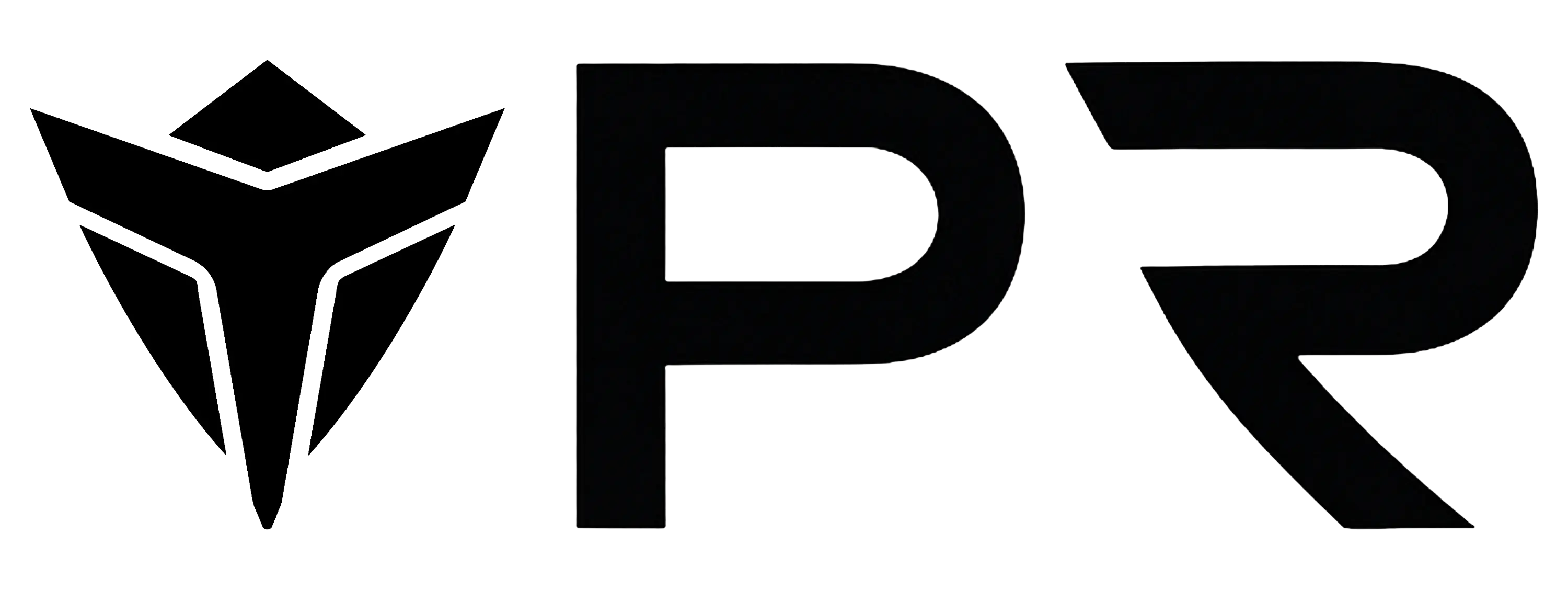


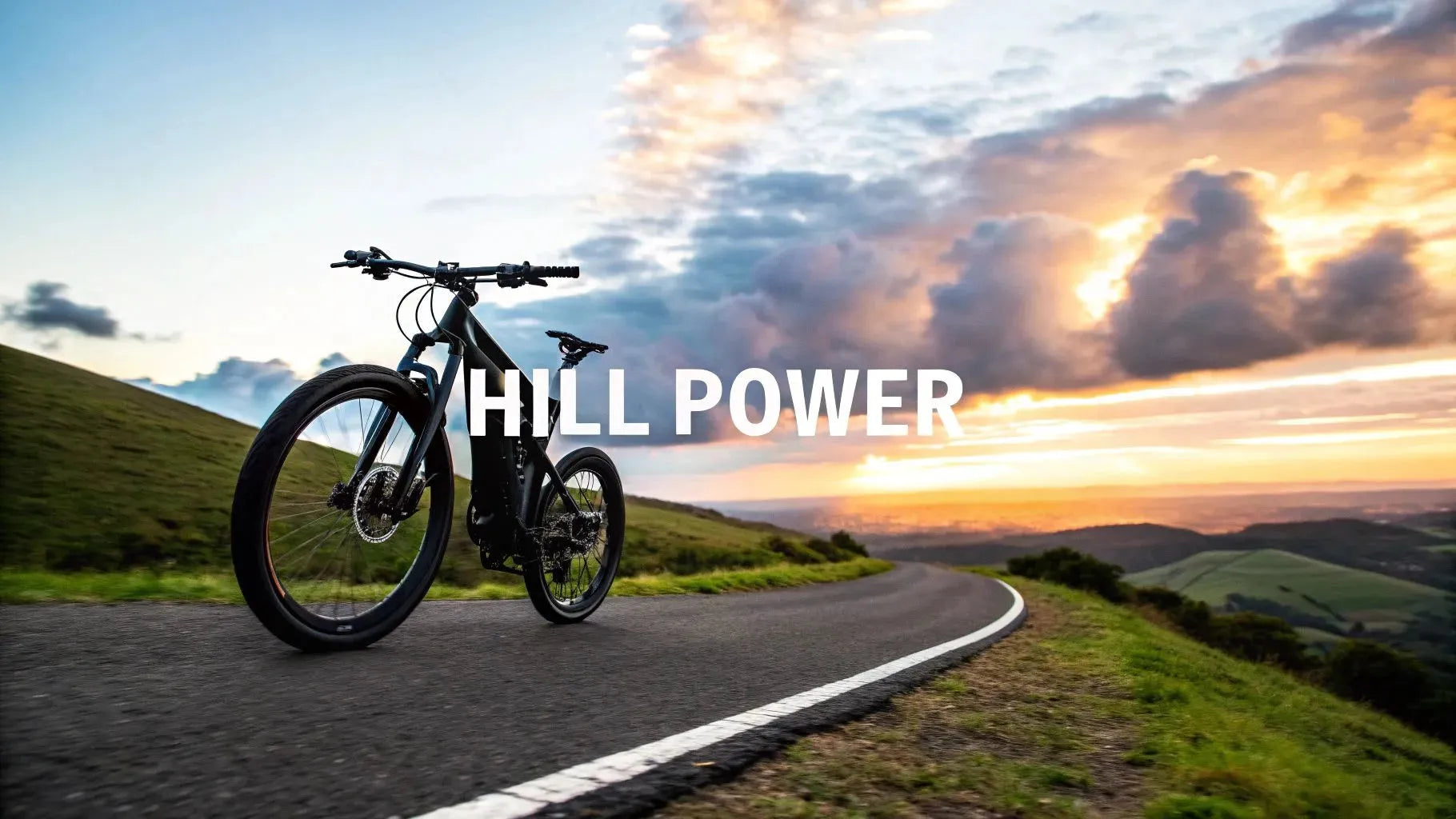
Share:
Best Lightweight Electric Scooters in the US & Australia
Best Ebike for Heavy Riders Top Picks